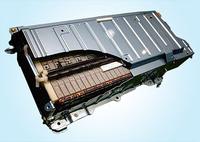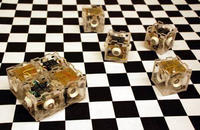-
Australians told sweeping economic, societal changes needed to cope with severe weather
The Australian government’s Productivity Commission has just released its much-anticipated report, titled Barriers to Effective Climate Change Adaptation; the report calls for sweeping changes across the Australian economy, including ditching property taxes which discourage people from moving out of areas prone to extreme weather events
-
-
Feminine math, science role models do not motivate girls

Women who excel in male-dominated science, technology, engineering, and mathematic (STEM) fields are often unjustly stereotyped as unfeminine; if women are perceived as having feminine qualities, however, their success may actually decrease interest in STEM, particularly among young girls, according to a new study
-
-
New micro helicopters for search and rescue missions
New micro helicopters have a diameter of about fifty centimeters, weigh only 1,500 grams; they do not rquire GPS or remote control to navigate; they are designed to maneuver in tight or even enclosed spaces, and to detect and fly around any obstacle; possible uses could include protection or rescue missions, and they are ideal for flying over disaster areas and giving a picture of the situation from the air or locating victims
-
-
New academic homeland security journal launched
The inaugural issue of a new academic, peer-reviewed journal — the Journal of Homeland Security Education (JHSE)— is out; JHSE will focus on innovative concepts and models, strategies, technical tools, and theoretical and observational analyses; it also provides a platform for translational research that connects education to practice
-
-
Identifying the sources of global sea level rise
As the Earth’s climate warms, a melting ice sheet produces a distinct and highly non-uniform pattern of sea-level change, with sea level falling close to the melting ice sheet and rising progressively farther away. The pattern for each ice sheet is unique and is known as its sea level fingerprint; now, geophysicists have found a way to identify the sea level fingerprint left by a particular ice sheet
-
-
Students need to be “switched on” to maths: researchers
The decline in children’s participation in mathematics can only be reversed by tackling a complex mix of factors, including positive and negative attitudes of a student’s parents, peers, and teachers
-
-
New monitoring system clarifies atmospheric CO2 questions
Most climate scientists believe higher concentrations of the greenhouse gas CO2 in Earth’s atmosphere are leading to rising temperatures on the planet; trouble is, CO2 is derived not only from fossil fuels, but is also being emitted by biological sources like plant respiration; CO2 released from fossil fuels has no carbon-14, while CO2 emitted from biological sources on Earth is relatively rich in carbon-14, allowing scientists to compare emissions from man-made fossil fuels to biologically emitted CO2
-
-
Border security bill would harm U.S. National Parks: environmentalists
A bill pending in the U.S. House of Representatives would suspend the enforcement of almost all the U.S. environmental laws on all lands under the jurisdiction of the Departments of the Interior and Agriculture within 100 miles of the northern border with Canada and the southern border with Mexico; the 100-mile zone includes fifteen National Parks which cover 21,657,399 acres, or nearly 25 percent of the overall footprint U.S. National Park System; supporters of the bill claim it would bolster border security, while environmentalists say it would gut a century’s worth of proven federal lands protection
-
-
Scientists: Deepwater Horizon exposed gaps in deepwater oil spill knowledge

On the second anniversary of the Deepwater Horizon oil spill in the Gulf of Mexico, a national team of scientists warns that inadequate knowledge about the effects of deepwater oil well blowouts threatens scientists’ ability to help manage comparable future events
-
-
Solar storms and infrastructure vulnerabilities

Space weather, and in particular coronal mass ejections, can cause huge disruption to many highly technological systems on Earth; experts say that vulnerable industries, such as power grids and airlines, should gather more information on space weather in order to make more informed decisions about how to deal with future solar storms
-
-
Efficiency of multi-hop wireless networks boosted
Multi-hop wireless networks can provide data access for large and unconventional spaces, but they have long faced significant limits on the amount of data they can transmit; now researchers have developed a more efficient data transmission approach that can boost the amount of data the networks can transmit by 20 to 80 percent
-
-
Honda to reuse rare Earth metals from used parts

Rare Earth elements are essential to advanced technological application and to green technology products; China controls 97 percent of the world’s production of these elements, and has been using its near-monopoly to hobble non-Chinese companies and for political blackmail; in response, two Japanese companies announce a new process allowing them to extract as much as 80 percent or more of rare Earth metals contained in used nickel-metal hydride batteries
-
-
Himalayan glaciers decline less rapidly than previously feared
Several hundreds of millions of people in Southeast Asia depend, to varying degrees, on the freshwater reservoirs of the Himalayan glaciers; it is thus important to detect the potential impact of climate changes on the Himalayan glaciers at an early stage; together with international researchers, glaciologists from the University of Zurich now show that the glaciers in the Himalayas are declining less rapidly than was previously thought; the scientists, however, see major hazard potential from outbursts of glacial lakes
-
-
Autonomous, self-replicating robots for finding extraterrestrials

Autonomous, self-replicating robots — exobots — are the way to explore the universe, find and identify extraterrestrial life, and perhaps clean up space debris in the process; scientists note that if aliens are out there, they have the same problems we do: they need to conserve resources, are limited by the laws of physics, and they may not even be eager to meet us
-
-
Cellphones could soon see through walls
Researchers have designed an imager chip that could turn mobile phones into devices that can see through walls, wood, plastics, paper, and other objects; the chip exploits the terahertz band of the electromagnetic spectrum, which is one of the wavelength ranges that falls between microwave and infrared, and which has not been accessible for most consumer devices
-
More headlines
The long view
New Technology is Keeping the Skies Safe
DHS S&T Baggage, Cargo, and People Screening (BCP) Program develops state-of-the-art screening solutions to help secure airspace, communities, and borders
Factories First: Winning the Drone War Before It Starts
Wars are won by factories before they are won on the battlefield,Martin C. Feldmann writes, noting that the United States lacks the manufacturing depth for the coming drone age. Rectifying this situation “will take far more than procurement tweaks,” Feldmann writes. “It demands a national-level, wartime-scale industrial mobilization.”
How Artificial General Intelligence Could Affect the Rise and Fall of Nations
Visions for potential AGI futures: A new report from RAND aims to stimulate thinking among policymakers about possible impacts of the development of artificial general intelligence (AGI) on geopolitics and the world order.
Smaller Nuclear Reactors Spark Renewed Interest in a Once-Shunned Energy Source
In the past two years, half the states have taken action to promote nuclear power, from creating nuclear task forces to integrating nuclear into long-term energy plans.
Keeping the Lights on with Nuclear Waste: Radiochemistry Transforms Nuclear Waste into Strategic Materials
How UNLV radiochemistry is pioneering the future of energy in the Southwest by salvaging strategic materials from nuclear dumps –and making it safe.
Model Predicts Long-Term Effects of Nuclear Waste on Underground Disposal Systems
The simulations matched results from an underground lab experiment in Switzerland, suggesting modeling could be used to validate the safety of nuclear disposal sites.
